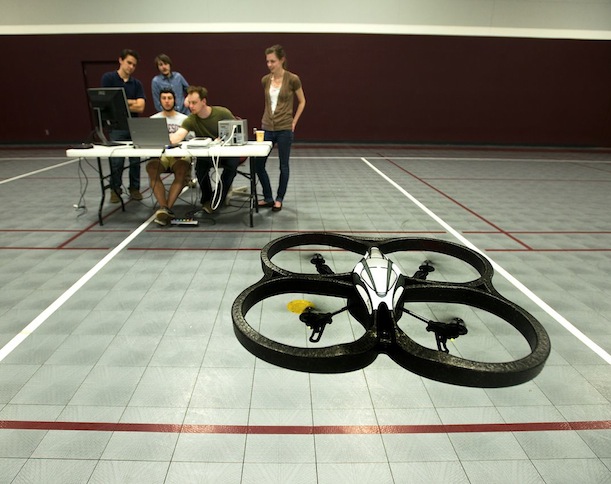VIDEO: This Helicopter is Controlled Entirely By A Person’s Thoughts
A new device can read your brain patterns to steer a toy helicopter—the mere thought of clenching your right fist veers the chopper right
![]()

A new system reads a user’s brain patterns to steer a toy helicopter—the first time a flight vehicle has been steered entirely by thought. Image via University of Minnesota
Think of clenching your right fist. A nimble 14-ounce helicopter flies right. Imagine clenching your left fist. The chopper veers left. Think of clenching both fists, and it ascends vertically.
This remarkable helicopter-control system is the work of a group of scientists at the University of Minnesota led by engineering professor Bin He. What sets it apart is that controlling its flight requires absolutely no actual movement for the pilot—no button-pushing or throttle-pulling. Instead of a conventional remote, users control the vehicle with a EEG (electroencephalography) cap studded with 64 electrodes, which detect electrical activity in different parts of the brain near the scalp, effectively reading their minds.
The system, first demonstrated in April and now fully described in an article published today in the Journal of Neural Engineering, is part of the burgeoning study of brain-computer interfaces—direct communication pathways between brains and computerized or robotic devices. In recent years, scientists have created mind-controlled robotics that can feed someone chocolate or help them drink coffee, but this is the first instance of a flight vehicle controlled entirely by thought.
The system relies upon previous EEG and other neurological research by the team, which identified which activity patterns in the brain correlated with thoughts such as “make a fist with your right hand” and “make a fist with both hands.” These sorts of movement-oriented thoughts occur mostly in the motor cortex, an area of the brain responsible for control of the body. The EEG cap is sensitive enough only to detect activity relatively close to the scalp—which is where the motor cortex is located—so the scientists were able to program their EEG software to distinguish between these relevant thought patterns in particular.
As a result, when the system senses one of the specified thoughts, it converts the thought (“make a first with my right hand”) into a command for the helicopter (“turn right”) and then sends the signal to the vehicle over Wi-Fi. With that, voilà: a thought-controlled helicopter.
The team had previously created a system that allowed users to control a virtual helicopter, and modified it for this study using an actual physical vehicle, the ARDrone Quadcopter. As part of the project, they gave five undergraduates a crack at flying the chopper, and all were able to figure out how to keep the thing aloft—and even fly it through hoops—with minimal training.
Scientists envision a range of applications for this sort of technology. Research is already underway for one of the most obvious uses: prosthetic limbs. In February, a Swiss team presented work on a mind-controlled artificial hand that allows a user to pick up objects and can even relay stimuli (such as the hand being poked by a needle) to the user’s brain. Others have worked on mind-controlled wheelchairs, which would give greater mobility to quadriplegic users.
One of the things that makes the helicopter experiment so interesting, though, is that like a few recent brain-computer interfaces (including the wheelchair), it involves brain patterns detected with a non-invasive procedure—users can simply put on or take off the EEG cap whenever they like. Compared to other sorts of brain-computer interfaces, which often rely upon surgically implanted sensors, this sort of system could be used in a much wider range of situations.
For one, paralyzed patients reluctant or unable to have costly and invasive surgery to become more autonomous can simply wear the cap. Additionally, amputees and patients who have a non-paralyzing ailment that still limits mobility—such as ALS or another neuromuscular disorder—could in theory use this sort of technology to control wheelchairs or even other vehicles, such as cars, without requiring a permanent brain implant system.
Someday, it could even be used to enhance technology use for people without related medical problems. If it becomes reliable and sensitive enough, for example, perhaps pilots could someday control full-size helicopters with their thoughts to reduce hand and arm fatigue, and surgeons could manipulate surgical instruments without having to worry about shaking hands.
/https://tf-cmsv2-smithsonianmag-media.s3.amazonaws.com/accounts/headshot/joseph-stromberg-240.jpg)
/https://tf-cmsv2-smithsonianmag-media.s3.amazonaws.com/accounts/headshot/joseph-stromberg-240.jpg)